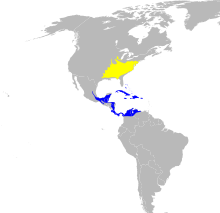
The orchard oriole is the smallest species of icterid. The subspecies of the Caribbean coast of Mexico, I. s. fuertesi, is sometimes considered a separate species, the ochre oriole or Fuertes's oriole.

The yellow-rumped warbler is a regular North American bird species that can be commonly observed all across the continent. Its extensive range connects both the Pacific and Atlantic coasts of the U.S. as well as Canada and Central America, with the population concentrated in the continent's northern reaches during the breeding season and migrating southwards to southern North and Central America in the winter. It generally prefers coniferous forests or mixed coniferous-deciduous forests as its breeding habitat, while during the winter it can be found inhabiting more open areas such as shrublands that offer food resources. The yellow-rumped warbler is primarily insectivorous, though the species does eat fruits such as juniper berries as well, especially in winter.

The Cape May warbler is a species of New World warbler. It breeds in northern North America. Its breeding range spans all but the westernmost parts of southern Canada, the Great Lakes region, and New England. It is migratory, wintering in the West Indies. This species is a very rare vagrant to western Europe, with two records in Britain as of October 2013. The English name refers to Cape May, New Jersey, where George Ord collected the specimen later described by Alexander Wilson. This species was not recorded again in Cape May for another 100 years, although it is now known as an uncommon migrant there.
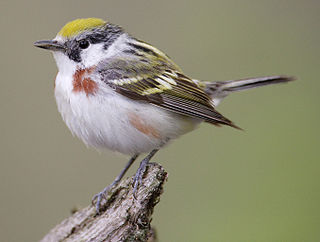
The chestnut-sided warbler is a New World warbler. They breed in eastern North America and in southern Canada westwards to the Canadian Prairies. They also breed in the Great Lakes region and in the eastern United States.

The magnolia warbler is a member of the wood warbler family Parulidae.
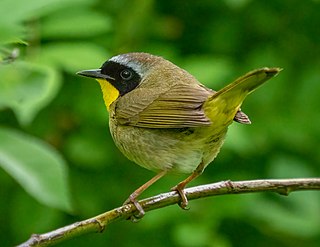
The common yellowthroat, also known as the yellow bandit or Maryland yellow-throat, is a New World warbler. It is an abundant breeder in North America, ranging from southern Canada to central Mexico. The genus name Geothlypis is from Ancient Greek geo, "ground", and thlupis, an unidentified small bird; thlypis is often used in the scientific names of New World warblers. The specific trichas is also from Greek; trikhas is a kind of thrush, the word being derived from trikhos, "hair".
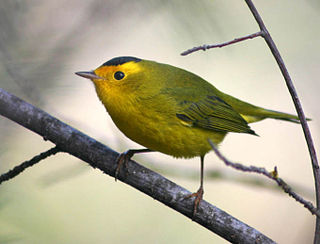
Wilson's warbler is a small New World warbler. It is greenish above and yellow below, with rounded wings and a long, slim tail. The male has a black crown patch; depending on the subspecies, that mark is reduced or absent in the female. It breeds across Canada and south through the western United States, and winters from Mexico south through much of Central America. It is a very rare vagrant to western Europe.
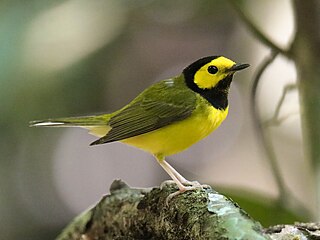
The hooded warbler is a New World warbler. It breeds in eastern North America across the eastern United States and into southernmost Canada (Ontario). It is migratory, wintering in Central America and the West Indies. Hooded warblers are very rare vagrants to western Europe.

The Tennessee warbler is a New World warbler that breeds in eastern North America and winters in southern Central America, the Caribbean, and northern South America. The specific name peregrina is from Latin peregrinus "wanderer".

The black-throated green warbler is a small songbird of the New World warbler family.

The mourning warbler is a small songbird of the New World warbler family. Mourning warblers are native to eastern and central North America as well as some countries in Central America. They are neotropical migrants and tend to be found in dense second growth forests. They are under the Wood-warbler category, which consists of arboreal and terrestrial colorful passerines. Wood warblers are in the order Passeriformes, which are perching birds including more than half of all bird species, and the family Parulidae which also includes the Common Yellowthroat, Black and White Warbler, Nashville Warbler, ovenbird, and American Redstart. They are very similar to the MacGillivray's Warbler in appearance, especially in females and immature birds, but their breeding range does not overlap into the west.

The palm warbler is a small songbird of the New World warbler family.

The Connecticut warbler is a small songbird of the New World warbler family.

The Nashville warbler is a small songbird in the New World warbler family, found in North and Central America. It breeds in parts of the northern and western United States and southern Canada, and migrates to winter in southern California and Texas, Mexico, and the north of Central America. It has a gray head and a green back, and its underparts are yellow and white.
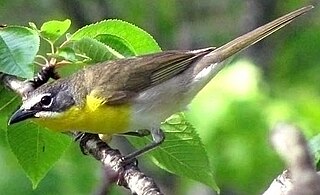
The yellow-breasted chat is a large songbird found in America, and is the only member of the family Icteriidae. It was once a member of the New World warbler family Parulidae, but in 2017, the American Ornithological Society moved it to its own family. Its placement is not definitively resolved.

The yellow-throated warbler is a small migratory songbird species in the New World warbler family (Parulidae) found in temperate North America.

The worm-eating warbler is a small New World warbler that breeds in the Eastern United States and migrates to southern Mexico, the Caribbean, and Central America for the winter.

Townsend's warbler is a small songbird of the New World warbler family.

MacGillivray's warbler is a species of New World warbler. These birds are sluggish and heavy warblers, preferring to spend most of their time on, or near the ground, except when singing.

The hermit warbler is a small perching bird. It is a species of New World warbler or wood-warbler. They are a migratory bird, the breeding range spanning the majority of the west coast of the United States. Their winter range includes parts of Mexico and Central America as well as parts of the southern California coast.

